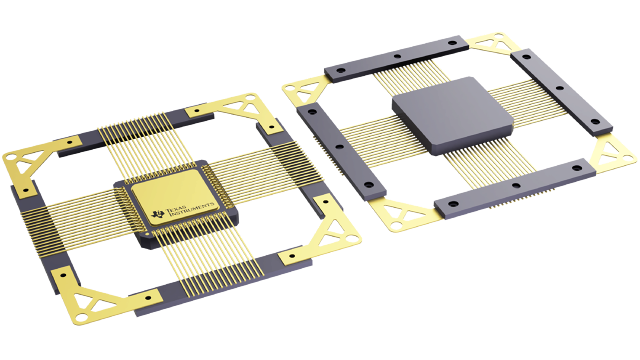Gehäuseinformationen
| Gehäuse | Pins CFP (HFG) | 68 |
| Betriebstemperaturbereich (°C) -55 to 125 |
| Gehäusemenge | Träger 1 | JEDEC TRAY (5+1) |
Merkmale von TLK2711-SP
- 1.6 to 2.5-Gbps (Gigabits Per Second) Serializer/Deserializer
- Hot-Plug Protection
- High-Performance 68-Pin Ceramic Quad Flat Pack Package (HFG)
- Low-Power Operation
- Programmable Preemphasis Levels on Serial Output
- Interfaces to Backplane, Copper Cables, or Optical Converters
- On-Chip 8-Bit/10-Bit Encoding/Decoding, Comma Detect
- On-Chip PLL Provides Clock Synthesis From Low-Speed Reference
- Low Power: < 500 mW
- 3-V Tolerance on Parallel Data Input Signals
- 16-Bit Parallel TTL-Compatible Data Interface
- Ideal for High-Speed Backplane Interconnect and Point-to-Point Data Link
- Military Temperature Range (–55°C to 125°C Tcase)
- Loss of Signal (LOS) Detection
- Integrated 50-Ω Termination Resistors on RX
- Engineering Evaluation (/EM) Samples are Available (1)
(1)These units are intended for engineering evaluation only. They are processed to a non-compliant flow (for example, no burn-in, and so forth) and are tested to temperature rating of 25°C only. These units are not suitable for qualification, production, radiation testing, or flight use. Parts are not warranted for performance on full MIL specified temperature range of –55°C to 125°C or operating life.
Beschreibung von TLK2711-SP
The TLK2711-SP is a member of the WizardLink transceiver family of multigigabit
transceivers, intended for use in ultra-high-speed bidirectional point-to-point data transmission
systems. The TLK2711-SP supports an effective serial interface speed of 1.6 Gbps to 2.5 Gbps,
providing up to
2 Gbps of data bandwidth.
The primary application of the TLK2711-SP is to provide high-speed I/O data channels for point-to-point baseband data transmission over controlled impedance media of approximately 50 Ω. The transmission media can be printed circuit board, copper cables, or fiber-optic cable. The maximum rate and distance of data transfer is dependent upon the attenuation characteristics of the media and the noise coupling to the environment.
This device can also be used to replace parallel data transmission architectures by providing a reduction in the number of traces, connector pins, and transmit/receive pins. Parallel data loaded into the transmitter is delivered to the receiver over a serial channel, which can be a coaxial copper cable, a controlled impedance backplane, or an optical link. It is then reconstructed into its original parallel format. It offers significant power and cost savings over parallel solutions, as well as scalability for higher data rates in the future.
The TLK2711-SP performs parallel-to-serial and serial-to-parallel data conversion. The clock extraction functions as a physical layer (PHY) interface device. The serial transceiver interface operates at a maximum speed of 2.5 Gbps. The transmitter latches 16-bit parallel data at a rate based on the supplied reference clock (TXCLK). The 16-bit parallel data is internally encoded into 20 bits using an 8-bit/10-bit (8b/10b) encoding format. The resulting 20-bit word is then transmitted differentially at 20× the reference clock (TXCLK) rate. The receiver section performs the serial-to-parallel conversion on the input data, synchronizing the resulting 20-bit wide parallel data to the recovered clock (RXCLK). It then decodes the 20-bit wide data using the 8-bit/10-bit decoding format resulting in 16 bits of parallel data at the receive data pins (RXD0–RXD15). The outcome is an effective data payload of 1.28 to 2 Gbps (16 bits data × the frequency).
The TLK2711-SP is available in a 68-pin ceramic nonconductive tie-bar package (HFG).
The TLK2711-SP provides an internal loopback capability for self-test purposes. Serial data from the serializer is passed directly to the deserializer, providing the protocol device with a functional self-check of the physical interface.
The TLK2711-SP has a LOS detection circuit for conditions where the incoming signal no longer has a sufficient voltage amplitude to keep the clock recovery circuit in lock.
The TLK2711-SP allows users to implement redundant ports by connecting receive data bus pins from two TLK2711-SP devices together. Asserting the LCKREFN to a low state causes the receive data bus pins (RXD0 - RXD15, RXCLK, RKLSB, and RKMSB) to go to a high-impedance state if device is enabled (ENABLE = H). This places the device in a transmit-only mode, because the receiver is not tracking the data. LCKREFN must be de-asserted to a high state during power-on reset (see Power-On Reset section). If the device is disabled (ENABLE = L), then RKMSB will output the status of the LOS detector (active low = LOS ). All other receive outputs will remain high-impedance.
The TLK2711-SP I/Os are 3-V compatible. The TLK2711-SP is characterized for operation from –55°C to 125°C Tcase.
The TLK2711-SP is designed to be hot-plug capable. An on-chip power-on reset circuit holds the RXCLK low, and goes to high impedance on the parallel-side output signal pins, as well as TXP and TXN during power up.
